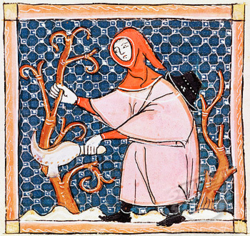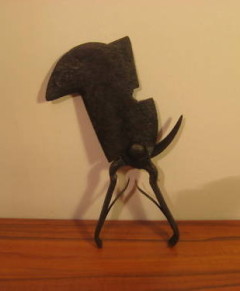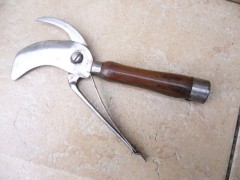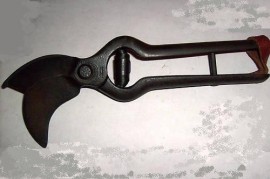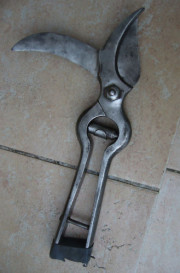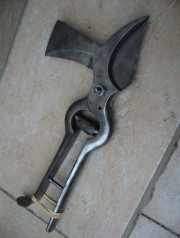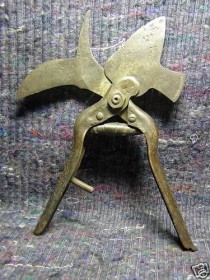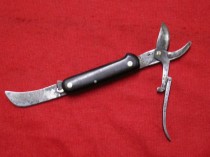Serpo-secateurs
The serpo-secateur is a hybrid tool, combining the cutting action of a billhook with a pair of secateurs. Prior to the beginning of the 19th century all garden and vineyard pruning was carried out using a pruning hook, a small billhook or 'serpette' in French. Sheap shears had been used since Roman times, and probably adopted by gardeners for trimming flowers, but grass was still being cut with a sickle or a scythe.
Around 1815, a French count, the Marquis Bertrand de Moleville, in exile in England from the Terror of the French Revolution invented a pruning tool that used a sliding blade, possibly influenced by the guillotine that had been chopping off his countrymen's (and women's) heads. The early types all appear to have two blades, one a thick narrow one with an obtuse edge, and the other a thin, wide cutting blade (the anvil type appeared much later).
John Claudius Loudon (1783 to 1843) mentions the French 'pruning shears' (Fig 124) in his 'Encyclopaedia of Gardening' (1822) which are similar to secateurs, and states they are 'an expedious instrument for pruning the vine'. In the 1831 edition the sécateur is shown as a distinct tool (Fig 389) of the same genre as pruning shears (Fig 391).
However gardening experts of the period decried its use (Encore en 1887 Louis HENRY, dans ses « Eléments d'Arboriculture Fruitière » émet certaines réserves sur le sécateur qui a « l'inconvénient, si bien fait soit-il, de comprimer, d'écraser toujours un peu l'un des côtés de la coupe). Consequently it did not become popular amongst French wine growers until the end of the 19th century, and in some rural areas not until after WWll.
The English gardener, William Robinson (1838 -1938) who visited France in the 1850's and 1860's, widely popularised the tool in England in the late 19th century, and indeed may have also led to its use becoming more widespread in France:
(A good secateur is a useful article: give it a trial. The Garden (an illustrated weekly journal) 1873
or
...the secateur is a valuable implement..... Parks and Gardens of Paris, William Robinson, 1883)
To try to interest a wider customer base, i.e. those who preferred to use a pruning hook, many makers of secateurs also made a combination serpo-secateur.
The variety of shapes and combinations of blade type is considarable, some being billhooks with a secateur blade, while others have additional pruning hook or even axe type chisel blades attached to more conventional secateurs...
